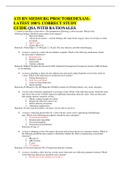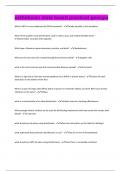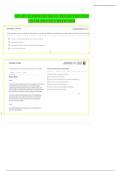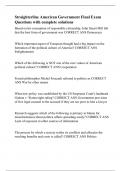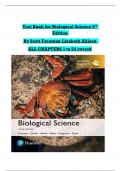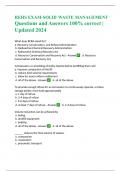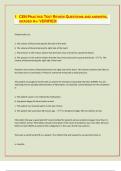PALS UPDATED FINAL EXAM 2023 -2024, Exams for Nursing BEST EXAMINATION STUDY GUIDE 2024 A 12-year-old child being evaluated in the pediatric intensive care unit displays the following ECG waveform. The team interprets this as which arrhythmia? - correct answer is; second degree Laboratory tests are ordered for a child who has been vomiting for 3 days and is diaphoretic, tachypneic, lethargic and pale. Which test would the provider use to determine the adequacy of oxygen delivery? - correct answer is; Lactate A 9-year-old patient is presenting with decreased breath sounds, bradycardia, slowed respiratory rate and a low O2 saturation level. The provider interprets these findings as indicating which condition? - correct answer is; Respiratory failure A 4-year-old child is brought t o the emergency department by the parents. Assessment reveals that the child has only gasping respirations and the pulse rate is 65 beats per minute. Which action would the provider initiate first? - correct answer is; Deliver 1 BVM ventilation every 3 to 5 seconds. A 15-year-old patient is being evaluated during a follow -up visit after being diagnosed with Lyme disease 2 months ago. A rhythm strip is obtained as shown below. The provider interprets this rhythm as indicating which arrhythmia? - correct ans wer is; First -
degree atrioventricular (AV) block A child in cardiac arrest experiences return of spontaneous circulation but is exhibiting signs of post -cardiac arrest syndrome (PCAS). The PALS resuscitation team determines that the child is experiencing a systemic response to ischemia/reperfusion. The team bases this determination on which finding(s)? - correct answer is; Hypotension Fever Hyperglycemia A 2-year-old child arrives at the emergency department with the parents. The child is unresponsive, is not breathing and has no pulse. Two emergency department providers begin high -quality CPR. Which action(s) by the providers demonstrates high -quality CPR? - correct answer is; Allowing the chest to recoil fully after each compression Providing ventilat ions that last about 1 second each Compressing the chest about 2 inches PALS UPDATED FINAL EXAM 2023 -2024, Exams for Nursing BEST EXAMINATION STUDY GUIDE 2024 Giving 2 ventilations to every 15 compressions A PALS resuscitation team is preparing to defibrillate a child experiencing cardiac arrest. For which rhythm(s) would this action be appropriate? - correct answer is; VF and pVT are shockable cardiac arrest rhythms. A provider is assessing a child with su spected shock. Which statement correctly describes hypotension and shock? - correct answer is; Hypotension is not a consistent feature of shock; A provider is caring for a 4 -year-old child in the urgent care clinic. Primary assessment reveals difficulty breathing and an oxygen saturation of 91%. The provider administers oxygen by nasal cannula with the goal of improving the child's oxygen saturation above what percentage? - correct answer is; Supplemental oxygen should be administered as needed to maintai n an oxygen saturation above 94%. An 11 -year-old soccer player is brought to the emergency department. After a quick assessment, the team realizes this patient is experiencing a severe asthma exacerbation. Which medication would the team administer first? - correct answer is; Albuterol plus ipratropium bromid A child in the pediatric step -down unit is exhibiting signs of respiratory distress. When assessing this child, which circulation finding might be present? - correct answer is; Pallor is a circulatio n finding that may be seen in patients with respiratory distress. A healthcare provider is performing a primary assessment of a child in respiratory distress. The provider documents increased work of breathing when which findings are observed? - correct a nswer is; Nasal flaring, use of accessory muscles to breathe and intercostal, substernal or suprasternal retractions are all indicators of increased work or effort of breathing. Grunting and inspiratory stridor are abnormal breath sounds. An 11 -year-old c hild develops unstable wide -complex tachycardia. Assessment reveals signs of significant hemodynamic compromise, but the child has a pulse. The PALS team would prepare the child for which intervention? - correct answer is; First -line treatment for unstable wide-complex tachycardias consists of synchronized electrical cardioversion, particularly when signs of hemodynamic compromise are apparent. A 4-month old infant is brought to the emergency department in cardiac arrest. Which condition would the team ide ntify as the most common cause of cardiac arrest in an infant of this age? - correct answer is; Sudden infant death syndrome
degree atrioventricular (AV) block A child in cardiac arrest experiences return of spontaneous circulation but is exhibiting signs of post -cardiac arrest syndrome (PCAS). The PALS resuscitation team determines that the child is experiencing a systemic response to ischemia/reperfusion. The team bases this determination on which finding(s)? - correct answer is; Hypotension Fever Hyperglycemia A 2-year-old child arrives at the emergency department with the parents. The child is unresponsive, is not breathing and has no pulse. Two emergency department providers begin high -quality CPR. Which action(s) by the providers demonstrates high -quality CPR? - correct answer is; Allowing the chest to recoil fully after each compression Providing ventilat ions that last about 1 second each Compressing the chest about 2 inches PALS UPDATED FINAL EXAM 2023 -2024, Exams for Nursing BEST EXAMINATION STUDY GUIDE 2024 Giving 2 ventilations to every 15 compressions A PALS resuscitation team is preparing to defibrillate a child experiencing cardiac arrest. For which rhythm(s) would this action be appropriate? - correct answer is; VF and pVT are shockable cardiac arrest rhythms. A provider is assessing a child with su spected shock. Which statement correctly describes hypotension and shock? - correct answer is; Hypotension is not a consistent feature of shock; A provider is caring for a 4 -year-old child in the urgent care clinic. Primary assessment reveals difficulty breathing and an oxygen saturation of 91%. The provider administers oxygen by nasal cannula with the goal of improving the child's oxygen saturation above what percentage? - correct answer is; Supplemental oxygen should be administered as needed to maintai n an oxygen saturation above 94%. An 11 -year-old soccer player is brought to the emergency department. After a quick assessment, the team realizes this patient is experiencing a severe asthma exacerbation. Which medication would the team administer first? - correct answer is; Albuterol plus ipratropium bromid A child in the pediatric step -down unit is exhibiting signs of respiratory distress. When assessing this child, which circulation finding might be present? - correct answer is; Pallor is a circulatio n finding that may be seen in patients with respiratory distress. A healthcare provider is performing a primary assessment of a child in respiratory distress. The provider documents increased work of breathing when which findings are observed? - correct a nswer is; Nasal flaring, use of accessory muscles to breathe and intercostal, substernal or suprasternal retractions are all indicators of increased work or effort of breathing. Grunting and inspiratory stridor are abnormal breath sounds. An 11 -year-old c hild develops unstable wide -complex tachycardia. Assessment reveals signs of significant hemodynamic compromise, but the child has a pulse. The PALS team would prepare the child for which intervention? - correct answer is; First -line treatment for unstable wide-complex tachycardias consists of synchronized electrical cardioversion, particularly when signs of hemodynamic compromise are apparent. A 4-month old infant is brought to the emergency department in cardiac arrest. Which condition would the team ide ntify as the most common cause of cardiac arrest in an infant of this age? - correct answer is; Sudden infant death syndrome

